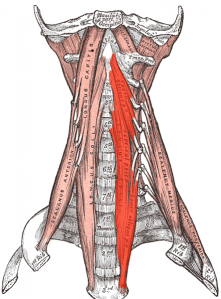Longus Colli
Original Editor - Wendy Walker
Top Contributors - Venus Pagare, Admin, Wendy Walker, Tarina van der Stockt, WikiSysop, Kim Jackson and Manisha Shrestha
Description[edit | edit source]
- Superior Oblique
- Inferior Oblique
- Vertical
Origin[edit | edit source]
C3 to T3
Anterior tubercles and anterior surfaces of bodies of C3 to T3
Superior Oblique portion arises from anterior tubercles of the transverse processes of the third, fourth, and fifth cervical vertebræ
Inferior Oblique portion arises from the front of the bodies of the first two or three thoracic vertebræ
Vertical portion arises from the front of the bodies of the upper three thoracic and lower three cervical vertebræ
Insertion[edit | edit source]
Anterior arch of atlas, anterior tubercles of C5-6, anterior surfaces of bodies of vertebrae C2-4
Superior Oblique portion inserts into the tubercle on the anterior arch of the atlas
Inferior Oblique portion into the anterior tubercles of the transverse processes of the fifth and sixth cervical vertebræ
Verticle portion into the front of the bodies of the second, third, and fourth cervical vertebræ.
Nerve Supply[edit | edit source]
C2-6
Ventral rami
Blood Supply[edit | edit source]
The muscle receives blood from the ascending cervical artery, which is a small branch of the inferior thyroid artery from the thyrocervical trunk of the subclavian artery. It also receives blood from the ascending pharyngeal artery. [1]
Action[edit | edit source]
Cervical flexion, ipsilateral side flexion and some cervical rotation
Function[edit | edit source]
As well as acting with the other cervical flexors to produce neck flexion, Longus Colli has been shown to have a postural function on cervical curvature, counteracting the lordosis increment related to the weight of the head and to the contraction of the posterior cervical muscles[2].
It is commonly implicated in whiplash[3]
Impaired strength and endurance of the deep neck flexors has been found to be a feature of cervicogenic headache[4].
References
[edit | edit source]
- ↑ http://www.anatomyexpert.com/structure_detail/5274/492/
- ↑ Mayoux-Benhamou MA, Revel M, Vallée C, Roudier R, Barbet JP, Bargy F. Longus colli has a postural function on cervical curvature. Surg Radiol Anat. 1994;16(4):367-71
- ↑ Jull, GA. Deep Cervical Flexor Muscle Dysfunction in Whiplash. 2000, Vol. 8, No. 1-2 , Pages 143-154
- ↑ Zito G, Jull G, Story Clinical tests of musculoskeletal dysfunction in the diagnosis of cervicogenic headache IMan Ther. 2006 May; 11(2):118-29







